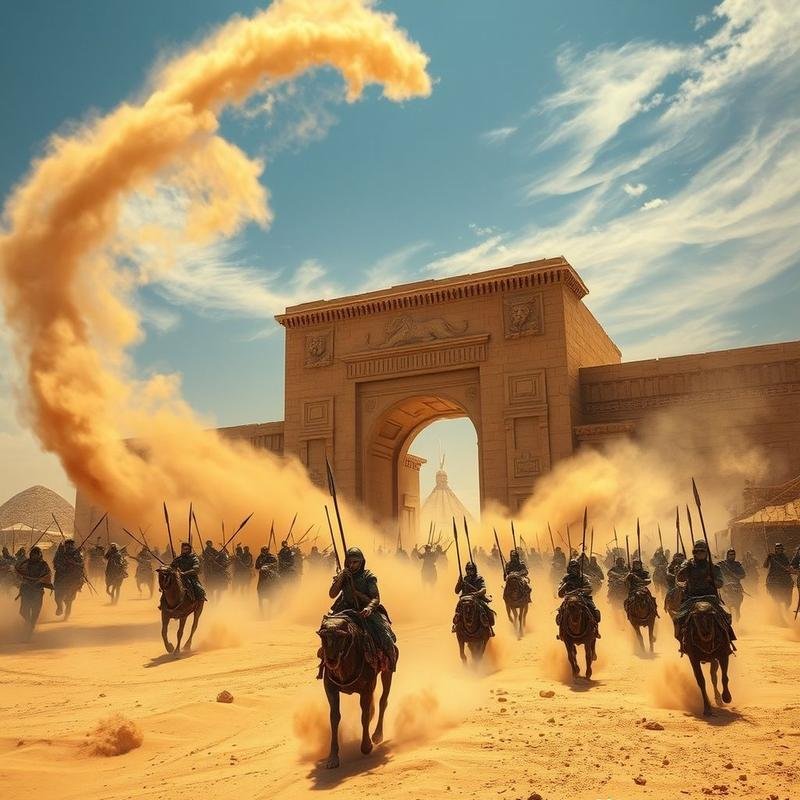Kush vs. Rome: Military Genius or Lucky Allies? 📜

Kush vs. Rome: Military Genius or Lucky Allies? 📜
The shadow of empire stretched long across the Mediterranean. Rome, insatiable in its hunger for land and resources, cast its gaze upon Egypt. By 30 BCE, Cleopatra’s reign had ended, and with it, the last vestige of independent Egyptian rule. Augustus, Rome’s first emperor, understood Egypt’s strategic importance. Its fertile lands were the breadbasket of the empire, its control essential for securing trade routes to the East. Egypt became a Roman province, governed directly by a prefect appointed by the emperor himself, a testament to its critical role. Roman legions, stationed along the Nile, ensured order and suppressed any potential rebellions. But beyond Egypt’s southern border lay the Kingdom of Kush, a powerful and wealthy civilization that controlled vital trade routes and gold mines. Romes ambition, however, knew no bounds. Whispers of Kushite riches soon reached Roman ears, planting the seeds of future conflict. Kush the forgotten kingdom of Nubia. For centuries, Egypt cast its gaze southward, toward Nubia – a land brimming with gold and undeniable power. As early as 2500 BC, the Kingdom of Kush emerged, a civilization inextricably linked to the lifegiving Nile, flourishing in what is now Sudan. Its capital, Kerma, rose as a shining example of advanced urban planning and intricate craftsmanship, rivaling even Egypt’s Old Kingdom. This proximity, while fostering cultural exchange, also ignited military rivalry. Driven by a hunger for Nubian resources, the Egyptians repeatedly invaded, triggering periods of Kushite dominance over Egypt itself. The most notable occurred during the 25th Dynasty, when Kushite kings – Piye and Taharqa among them – ruled from Memphis. This era witnessed a renaissance of Egyptian art and architecture, infused with Kushite elements. Renowned for their skilled archers, swift cavalry, and mastery of iron weaponry – a technology they may have pioneered independently – Kushite armies were a force to be reckoned with. Their control over vital trade routes along the Nile, forging connections between Central Africa and the Mediterranean, made them undeniably wealthy, a wealth that Rome coveted. The Kushite kingdom wasnt merely a passive recipient of Egyptian influence; it was a dynamic force shaping its own destiny. The Kushite army, unlike the legionaries marching from Rome, was forged in the crucible of the African landscape. Their mastery of the composite bow – a weapon demanding immense skill and strength – allowed Kushite archers to rain down arrows upon the enemy with deadly accuracy. Formations shattered long before Roman soldiers could engage. These were not merely skirmishers. Kushite archers were often heavily armored, fully capable of holding their own in brutal close combat. Beyond archery, the Kushites possessed a formidable cavalry arm. Unlike the primarily infantrybased Roman legions, Kushite cavalry provided crucial mobility and flanking capabilities. Depictions on temple walls at Musawwarat esSufra showcase Kushite horsemen, clad in scale armor, wielding spears and swords. These warriors were capable of swift maneuvers across the open plains. Their horses, likely of Nubian stock known for their stamina, allowed for rapid deployment and harassment tactics, relentlessly wearing down the enemy. Furthermore, the Kushites were early adopters of iron weaponry. While the Romans also utilized iron, the Kushites, controlling vital iron ore deposits and developing sophisticated smelting techniques perhaps as early as the 7th century BCE, may have possessed a technological edge. The quality and availability of iron for their weapons and armor could have been superior. This advantage, coupled with their skilled craftsmanship, resulted in durable and effective swords, spears, and shields, granting them a significant edge in closequarters combat against the bronze weaponry still prevalent in some Roman auxiliary units. Their battlefield tactics incorporated a blended arms approach archers to soften enemy lines, cavalry to exploit weaknesses, and heavily armed infantry to deliver the final blow. A complex and coordinated strategy that often caught the Romans completely off guard. The Kushite militarys sophisticated organization and innovative use of technology reveal a society capable of adapting and excelling in warfare. Military prowess alone rarely secures lasting victory. The Kushites, acutely aware of this, engaged in a complex game of political maneuvering. While direct evidence is fragmented, tantalizing hints within Roman and Egyptian records suggest a sophisticated network of alliances. One crucial element was likely fostering discontent within Egypt itself. The reigns of the early Roman emperors were marked by heavy taxation and cultural insensitivity, breeding resentment among the native Egyptian population. Kushite envoys may have subtly encouraged this dissent, promising support for rebellions that would tie down Roman forces and divert their attention from the southern border. Beyond Egypt, did the Kushites cast their net wider, seeking alliances with other regional powers wary of Roman expansion? The Garamantes, masters of the Sahara and frequent adversaries of Rome, present a plausible partner. Controlling vital trade routes, the Garamantes could disrupt Roman supply lines and provide Kush with valuable intelligence. Similarly, nomadic tribes inhabiting the Eastern Desert might have been drawn into the Kushite orbit, harassing Roman patrols and acting as scouts. The true extent of these alliances remains shrouded in the sands of time, but their potential impact on Kushite resistance cannot be ignored. The desert holds its secrets well, and the Kushites were adept at navigating its treacherous political landscape. They understood that survival required more than just strength; it demanded strategic alliances and the ability to exploit the weaknesses of their enemies. Emboldened by early victories in Egypt, the Roman prefect Gaius Petronius dared to venture south, invading Kushite territory around 25 BC. His objectives? Napata, the venerable former Kushite capital, and Meroë itself. Petronius may have plundered Napata, but he quickly discovered the Kushites, led by the indomitable Queen Amanirenas, were far from broken. In a stunning display of defiance, they launched a raid on Romanheld Aswan, seizing valuable bronze statues, including one of Emperor Augustus himself – a potent symbol of Roman power. This act ignited a furious Roman counterattack. Roman legions marched as far as Meroë, but the Kushites, masters of desert warfare, relentlessly harassed their extended supply lines and turned the unforgiving environment against them. Even in direct confrontations, such as those near Qasr Ibrim, the effectiveness of Kushite archers against Roman infantry became painfully clear. Amanirenas, often portrayed as a oneeyed warrior queen, rose as an enduring symbol of Kushite resistance. But at what cost? By 22 BC, both sides, wearied by constant conflict and attrition, turned to negotiation. Remarkably, the resulting treaty heavily favored Kush. Rome surrendered its territorial claims south of the Dodecaschoenus, a region just south of Aswan, and Meroë was freed from paying tribute. This landmark treaty, which endured for centuries, stands as a powerful demonstration of the Meroitic Kingdom’s extraordinary resilience and its ability to halt Roman expansion – a lasting tribute to the strategic brilliance of its leaders and the unwavering resolve of its people. The Kushite ability to fight the Romans to a standstill and secure favorable terms highlights their military and political sophistication. Beyond victory, the Kushite resistance profoundly reshaped Roman ambition in Africa. The treaty of Dodecaschoenus wasn’t merely a border agreement; it was a symbolic check on Rome’s aura of invincibility. Rome continued its dominance in North Africa, but its southern expansion stalled, allowing Kush to safeguard its cultural identity and political autonomy. This resistance fostered a sense of unique Kushite identity, evidenced by the continued use of the Meroitic script and the soaring silhouettes of distinct architectural marvels, such as the pyramids of Meroë, built long after Roman influence permeated the North. The Kushite kingdom, though eventually weakened by internal strife and external pressures from the rising kingdom of Aksum, left an enduring legacy of selfdetermination. Their success in halting Roman expansion preserved their unique cultural heritage and cemented their place as a formidable power, a beacon of resistance against an empire that believed itself unstoppable. The story of Kush challenges the notion of inevitable Roman dominance and underscores the importance of understanding the perspectives of those who resisted imperial power. Their legacy continues to inspire. Rome’s eagles did not cast an unchallenged shadow across the ancient world. The Kushite resistance reveals a crucial truth Roman power was not absolute, its expansion not inevitable. The campaigns of figures like Petronius, while initially successful, ultimately stalled before the resilience of the Meroitic kingdom. Their success was forged not only on the battlefield but also in the art of diplomacy, in forging alliances against a common foe. By recognizing Kush’s agency, we challenge the Eurocentric narrative that has long dominated historical discourse. The story of Kush serves as a potent reminder that history is a tapestry woven with threads of resistance, each one vital to understanding the whole. The Kushites carved their own path, defying the expectations of a world dominated by empires. They controlled their destiny. Considering the complex interplay of Kushite military innovations, political alliances, and environmental factors that contributed to their resistance against Roman expansion, challenging the conventional narrative of Roman invincibility, what other overlooked factors do you believe played a crucial role in Kushs ability to defy Rome? Share your insights in the comments below.









